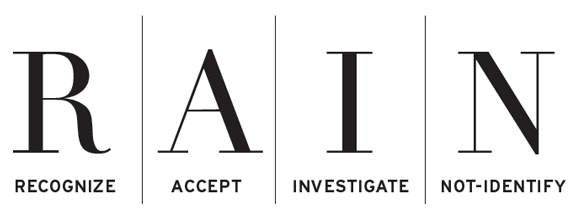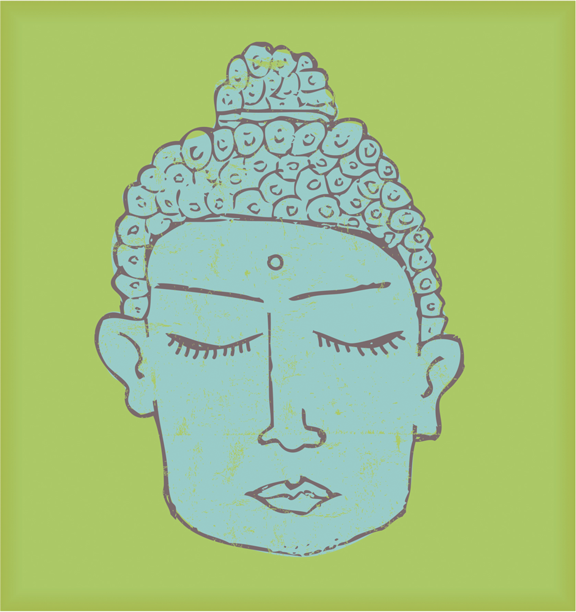
Getting started on a spiritual path takes guts. We usually don’t know it in the beginning, but if we keep going on it—if we really want to know the truth of what it means to be human or if we are deeply finished with our suffering—we will learn that walking the path of freedom takes a humble courage. It also takes determination, humor, a balanced effort, and the willingness to feel, directly in our body, the suffering brought by attachment to our conditioned thoughts, which create separation, dis-ease, and the greed and aversion we usually use to seek happiness. But the promise is real. We can be free of suffering; we can know our wide-awake mind and the open heart that goes with it.
The way the path works, it seems to me, is in two streams. One stream has to do with insight. We can’t control that; we can just create conditions in which insight is more likely to happen. We can be curious and open. We can inquire. And eventually, if we are lucky, the mind will wake up to itself and know its true nature. This is a first insight. From there, if we keep going, many other insights are possible— that we are one life; that the nature of everything is its emptiness; that each particular manifestation is a unique miracle. Then the challenge is to embody whatever insight we have in our daily life.
In the other stream, there is much paddling to do. Meditation is absolutely necessary. Developing continuity of mindfulness all day long is necessary. One tool that I’ve found to be extremely helpful for this practice is the acronym RAIN, originally created by the Insight Meditation Society teacher Michele McDonald and more thoroughly discussed by Diana Winston in Wide Awake and Tara Brach in True Refuge. RAIN is extremely helpful in dealing with the difficult emotions, sensations, and thoughts that bring us suffering.
R stands for recognizing what is happening in this moment. Someone just walked too close to you on the sidewalk or didn’t give you what you feel is your “right of way,” and boom, you’re angry. The “R” is simply to notice what is happening, to be present enough to know that something is happening. This is not a small thing. Many people are immediately reactive—and worse, they blame the other person for causing their reaction. The point is to be awake, to pay attention.
A stands for accepting. This does not mean that you wanted what just happened to happen. It simply means that you acknowledge that it did. You name it: for example, “anger is here.” The idea is that although you are not going to indulge the emotion or thought with further thinking or righteousness or another emotion, neither do you resist or avert or distract yourself from what’s happening. You simply acknowledge and name what is happening. You are willing to be open to whatever it is.
I stands for investigating the sensations in the body. This step is primarily a physical noticing. What does anger feel like? The heart beats faster, there can be a flush of energy and heat and a tightening of certain muscles. These physical events are what we label as “anger.” This energetic emotional component has to be willingly and thoroughly felt until the body returns to open relaxation. You breathe and wait and breathe and feel the body, at first tight and then slowly changing, relaxing and opening, letting go. If this is not thoroughly done, then we haven’t really felt the emotion that was triggered by the initial thought, and that energy gets stuck in the body and adds to the conditioned structure that was triggered in the first place. This openness to the physical event is what integrates the energy, dissipates it, and—if it is practiced over and over— eventually dissolves that particular egoic structure, which has no concrete core. The realization that the egoic system will eventually dissolve if we don’t add more thought or energy to it is a wonderful one when first experienced, and a real taste of the potential freedom to come if we continue with practice.
N stands for not identifying. There’s no need to identify a “me’” in what just happened. It was just a passing mental and emotional event, like watching a scene in a movie or the clouds as they move through the sky. We don’t have to build and rebuild a “me” on the passing content of the body-mind. Instead, we can stand as the observer. This not-identifying is tricky, but when the first change of identity shifts from the content of mind to the observer, we can see that the content is not who we are. This is the first real shift of freedom. Eventually identification as “the observer” drops away as well, but to simply make the shift is a good place to start.
With RAIN, we remember that waking up, reconnecting with life as a whole, is a possibility for each of us. It is our birthright.
♦
Learn more in Teah Strozer’s online Dharma Talk, “Life Hurts: Responding with RAIN.”
Thank you for subscribing to Tricycle! As a nonprofit, we depend on readers like you to keep Buddhist teachings and practices widely available.
